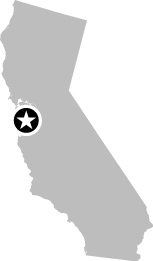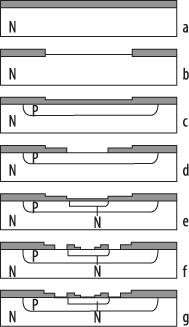085
844 E. Charleston Road, Palo Alto, CA
 37° 25′ 19.02″ N, 122° 6′ 12.18″ W
37° 25′ 19.02″ N, 122° 6′ 12.18″ W
![]()
Fairchild and the Fairchildren
Shockley Semiconductor (see Chapter 84) spawned the prototypical Silicon Valley startup company, Fairchild Semiconductor, founded in 1957. Innovative yet focused on products, not just research, Fairchild went on to spawn many other Silicon Valley greats (including Intel, LSI Logic, and AMD), and its offspring are frequently referred to as the Fairchildren. And it was at Fairchild that the planar process for silicon chip manufacturing was invented.
Around the same time, in 1958/1959, Jack Kilby (at Texas Instruments) and Robert Noyce (at Fairchild) invented the integrated circuit, where multiple transistors (and other components) were made on a single piece of silicon. Kilby built a circuit based on the mesa process (see sidebar) and connected the components with fine gold wires; Noyce’s circuit used the planar process, which had superior wiring. The planar process won the day, but Kilby won the Nobel Prize.
Using the planar process, Fairchild was able to build working integrated circuits and started supplying prototypes in 1960. In 1961 it announced a line of integrated circuits with the claim that they would reduce the size of a computer by up to 70%. The simple circuits included logic and flip flops (which can act as a single bit of memory, being either on or off), and were the forerunners of the microchip revolution that continues to this day. Each chip had just a few transistors on it—a flip flop can be made with just two—but the number of transistors on a chip would rapidly increase.
In 1965 Gordon Moore (one of Fairchild’s founders) wrote an article in Electronics entitled “Cramming More Components onto Integrated Circuits.” In it he noted that the number of components on an integrated circuit would double every two years (he estimated that by 1975 there would be around 65,000 components on a single chip). This prediction is now known as Moore’s Law and still holds true today (for example, the Intel Itanium Tukwila processor has 2 billion transistors on a single chip). The law has also been extended into other areas of digital electronics, including hard disk capacity and the number of pixels per dollar on digital cameras.
Fairchild grew and was successful in the new integrated circuit marketplace (playing second fiddle to Texas Instruments), but in 1968 Gordon Moore and Robert Noyce left after the company got into financial trouble. Their next startup, Intel, is a household name. Fairchild Semiconductor exists to this day.
The actual Fairchild building is still standing at 844 E. Charleston Road in Palo Alto. Unfortunately, like the Shockley Semiconductor Laboratory building, there’s no actual technology to be seen (the building is not even occupied by a technology firm), but a photograph of the scientific tourist next to the state historic monument marker is a must for any nerd’s photo album.
After you’ve had your photo taken at the Fairchild building, check out the HP Garage (see Chapter 90), which is just a short drive away, also in Palo Alto.
The Fairchild building is now occupied by a design firm called Collective Creations. Outside the building is a plaque erected by the California Department of Parks and Recreation, commemorating it as the site of the first “commercially practicable integrated circuit.”
